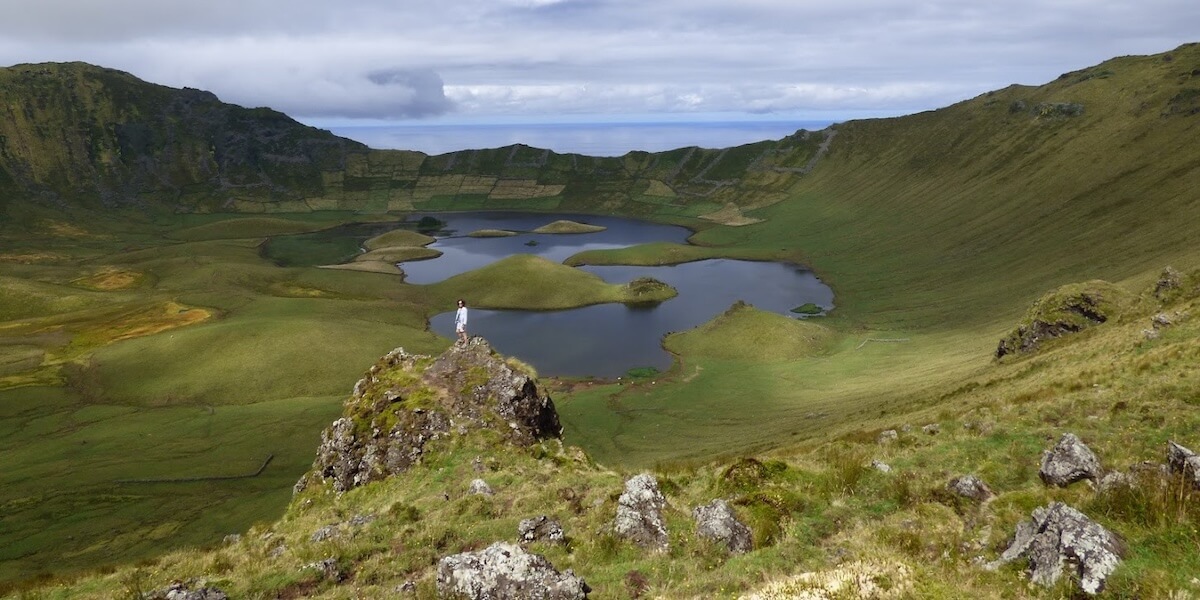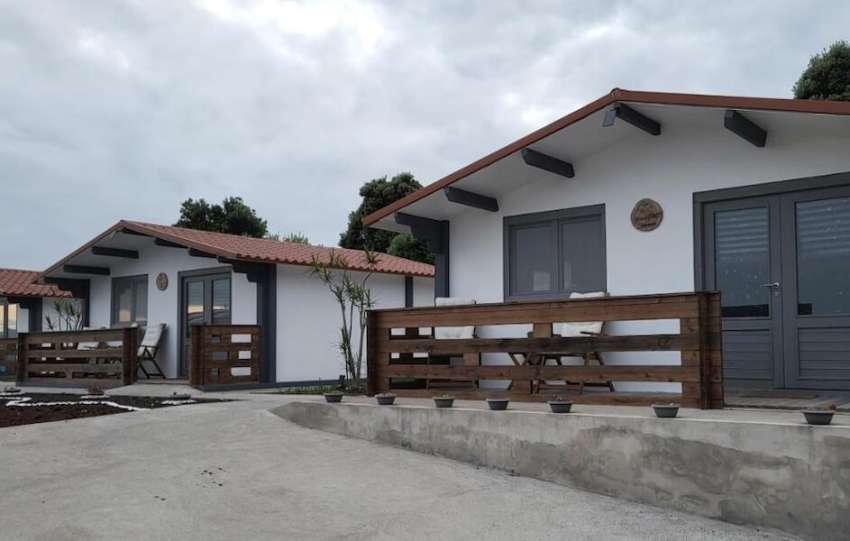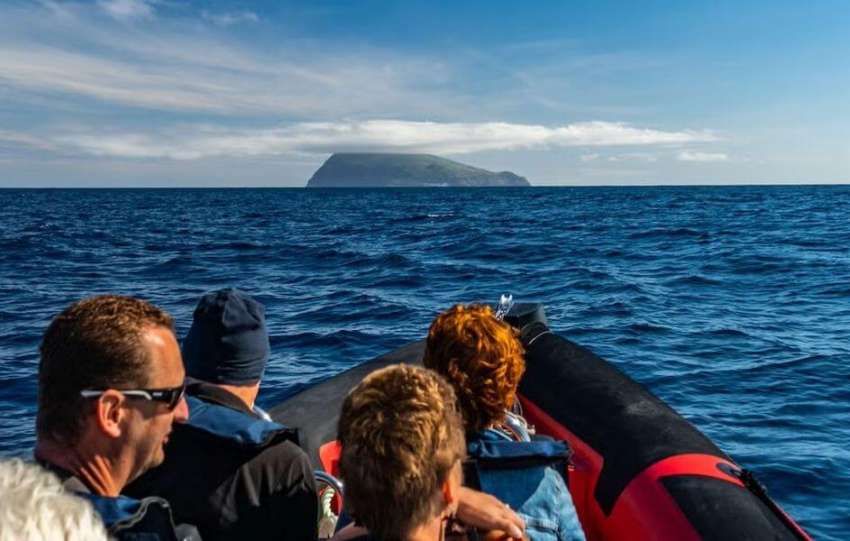Share This Article
With a coastline of towering cliffs surrounding almost the entire island, surrounded in winter by an often raging sea, the people of Corvo were, in the past, deprived of contact with the outside world for weeks at a time.
Despite the ultraperipheral reality of all the islands of the Azores, it is here that the insularity is still felt most. Vila do Corvo is the only settlement on the island. Built on a small platform of flat land that contrasts sharply with the rest of the island, and which extends to the south, it had more than 850 residents in the second half of the 19th century and today it has just over 400.
Indeed, Corvo Island is VERY small and yet, it is one of the most beautiful islands in the Azores. Therefore, I wrote this guide of the things to do in Corvo island. I hope you like it!
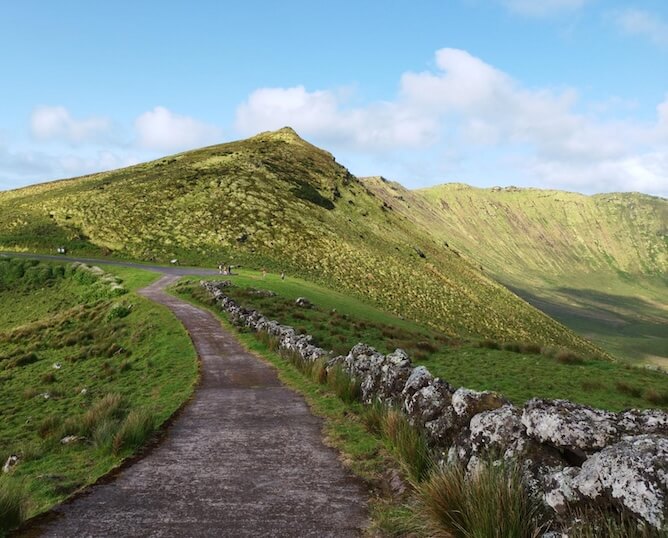
Best things to do in Corvo island
Take one of the island’s two trails
PRC02 COR Caldeirão
The PRC02 COR Caldeirão is the most famous hiking trail in Corvo Island. It is an easy circular trail that will take around 2h30 to complete. And to do it, my friend, is not just one of the best things to do in Corvo island but in the entire Azores.
If visibility is poor, you may have difficulty finding your way around, despite the many signs that mark the route. However, even if the road is foggy, the lower part of the caldera can be clear enough to allow for a pleasant walk.
The descent to the 2 lagoons at the bottom of the Caldeirão is via a zigzag path, muddy and slippery due to the water that runs down it, and that even in summer forms small streams in some places.
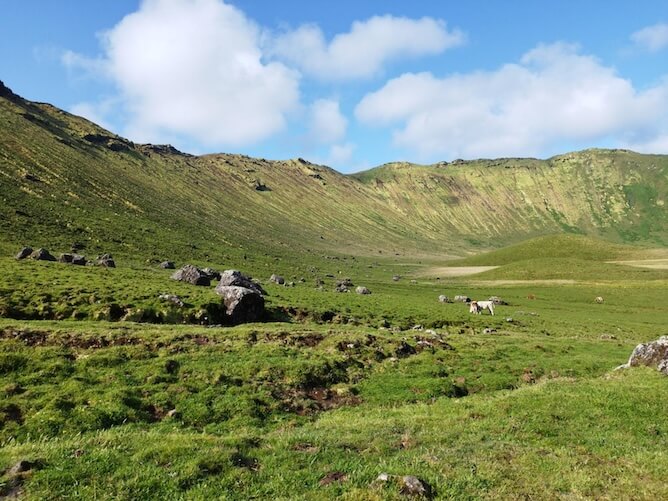
In the Caldeirão you will find permanent pastures, but also important natural habitats such as peat bogs, Macaronesian heaths and lagoons. Down below, the whistling of the wind is less intense, allowing the Hipparchia azorina, an endemic butterfly with a brownish colour and black spots, to fly by.
Below, go around the lagoons on whichever side suits you best, as you will end up returning to the same place to leave Caldeirão.
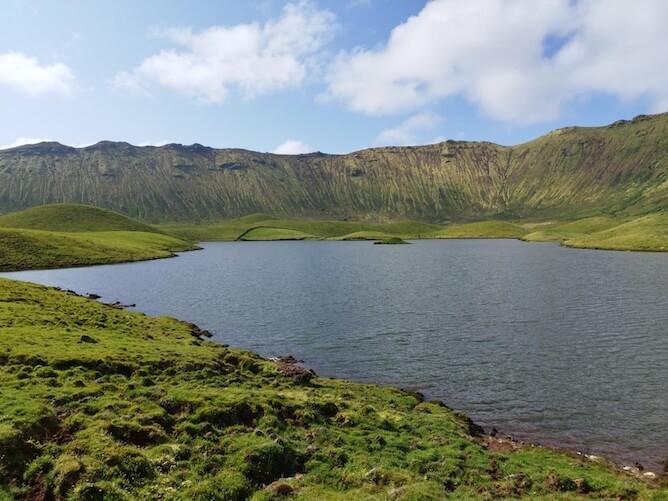
In the past, the people of the island kept livestock in the caldera, including sheep and pigs, and, imagine, they even grew potatoes. None of that can be seen anymore. Just a few dozen multicoloured cows grazing inside, occasionally breaking the silence with their mooing.
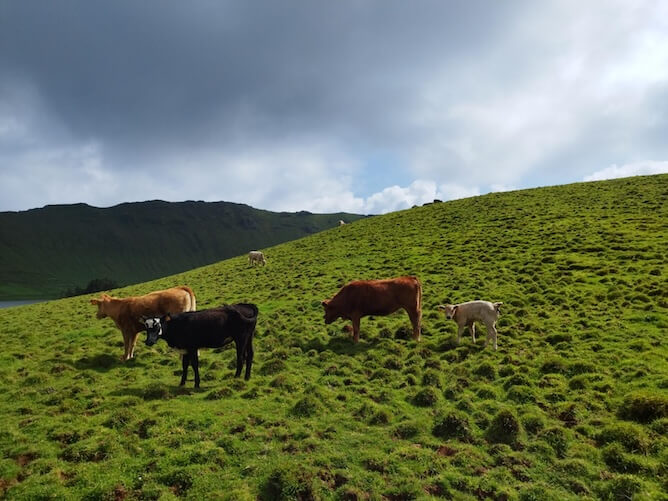
When you go around the second lagoon, you will find a small wood of cryptomeria and some marshy areas, so be extra careful where you step. Continue until you find the access that took you inside Caldeirão and do it in the opposite direction, until you reach the point where you started.
Practical information about this trail
- Distance to cover: 4,8 km.
- Average duration: 2h30.
- Type of trail: circular.
- Difficulty: Medium.
- Trailhead: Miradouro do Caldeirão (it’s a viewpoint).
PR01 COR Cara do Índio trail
Depending on how much time you have available on the island, after finishing the PRC02 COR Caldeirão, you can take a taxi back to the town of Corvo or you can take the PR01 COR Cara do Índio trail.
Both trails begin in the exact same place, Miradouro do Caldeirão, but the PR01 COR Cara do Índio trail has the advantage of finishing in the town of Vila do Corvo, which means that, by the end of it, you don’t need to call a taxi to go to the port.
As you go down the path that leads to the pastures, you will notice the whitewash on the stone walls. They had these purposes: to divide the property, to protect livestock and agricultural crops from the wind, or to store excess stone from the land.
After a 150m descent, the path turns left and continues for another 150m on flatter terrain, until it reaches a fork. Continue to the right until you enter a pasture. Jump over to the next pasture and continue in the same direction, leaving a small elevation with rocky outcrops on the left.
Continue until you reach the coastal cliff where you can see the entire northern coast of Flores island, and where there is a sign indicating the “Cara do Índio”. There, look carefully down towards the sea and you should be able to see this curious shape, naturally carved into the cliff, which resembles the profile of an Indian’s face. Continue down towards the village, always close to the cliff.
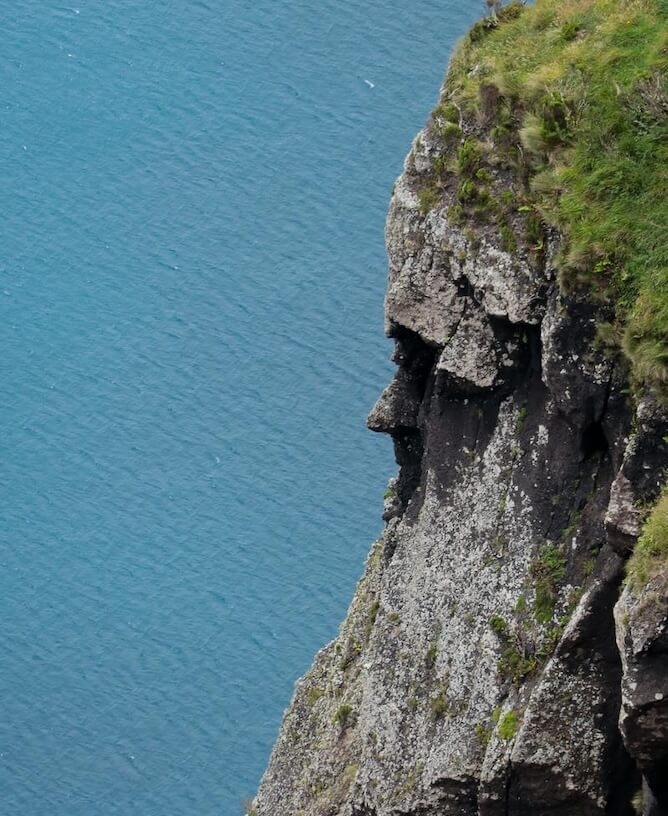
The monotony of the biodiversity of the pastures contrasts with that of the ravines, where Picconia azorica, Soiidago sempervirens, Juniperus brevifolia and other species grow.
A few steps ahead and the Vila do Corvo reveals itself to your eyes. The trail signs will take you across some pastures, turning left without going too far down, until you reach the old path that gave access to the higher ground of Morro da Fonte, which you will now have to go down.
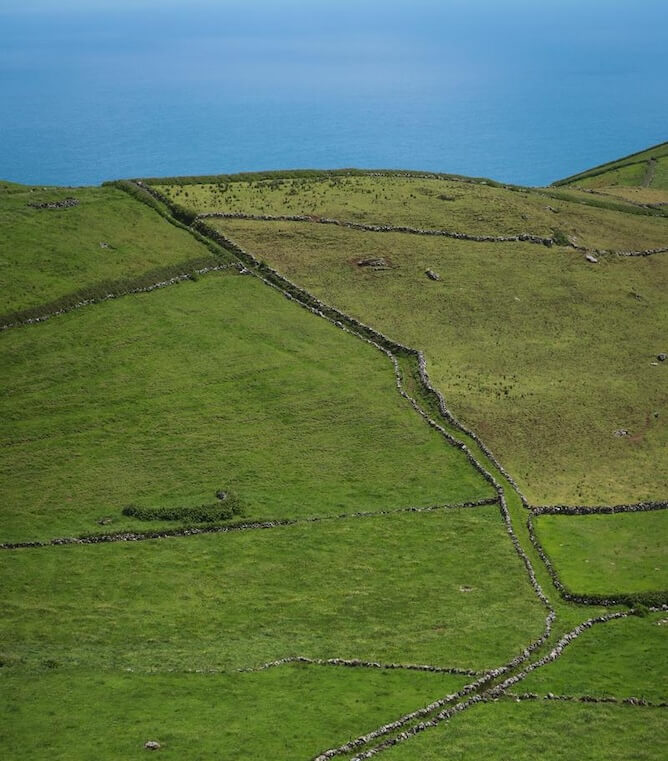
You will pass a rock that was worn down by man to serve as a temporary shelter, and finally reach the road, next to a water catchment. Climb 50m to the Sítio do Portão viewpoint to see and appreciate Vila do Corvo again.
Go down the road for about 30 m and join Caminho da Fonte Velha. A few metres below, you will reach the road and then return to the old path, next to a sign indicating where this trail ends: “Praia 2 km”. You will now wind through the narrow alleys of the village.
Go down to Largo do Outeiro, which was the social/religious centre of the town. Go right and then left down Rua da Matriz. You will reach the church of Nossa Senhora dos Milagres, where her image is venerated, a valuable Flemish sculpture from the beginning of the 16th century. This is where the trail ends.
Practical information about this trail
- Distance to cover: 10,3 km.
- Average duration: 3h.
- Type of trail: linear.
- Difficulty: Medium.
- Trailhead: Miradouro do Caldeirão (it’s a viewpoint).
Enjoy the view from the Caldeirão viewpoint
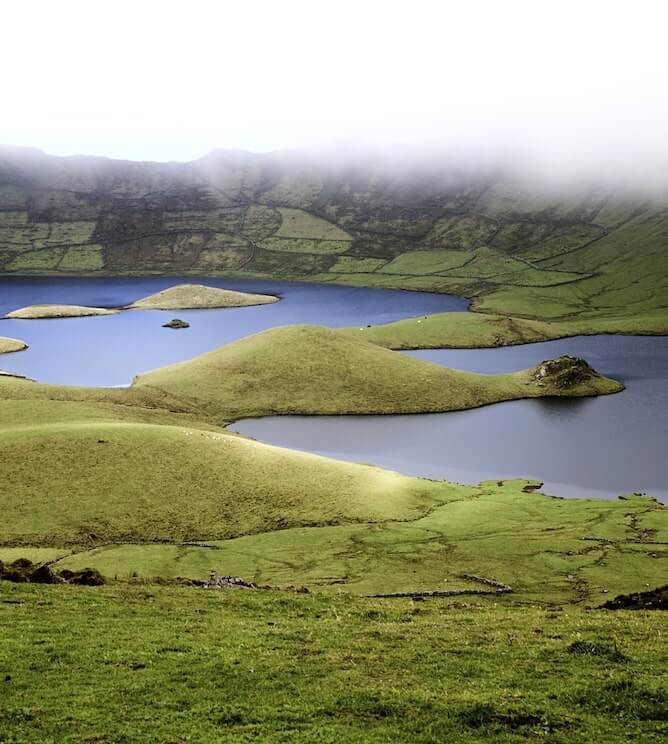
Even if you don’t feel like walking at all, it is still really worth it to enjoy the view of the volcano crater – it’s one of the best views in the Azores and one of the best things to do in Corvo island! To enjoy the view, simply head to the Caldeirão Viewpoint. I only recommend doing so on a day with good visibility and, preferably, without rain or wind, otherwise the experience will be fruitless.
Do some birdwatching in Corvo island
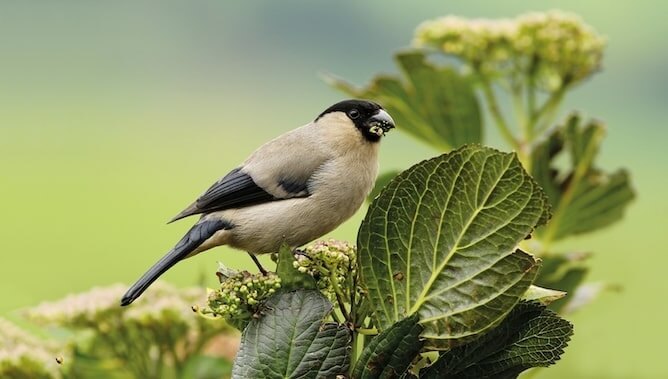
Autumn is when birdwatchers flock to photograph migratory birds that come here to rest, eat or even nest after their journeys across the North Atlantic. It is possible to hear and see the Galiinago gallinago, which is common here, the Sterna hirundo or the Anas platyrhynchos, as well as other rare species. Among these, due to its historical importance on the island, the Puffinus puffinus stands out, as it was hunted for its meat, feathers and “grease” used in oil lamps to light homes. Currently, this North Atlantic species, with only around 200 pairs, nests exclusively on Flores and Corvo islands, its southern limit on the planet. Therefore, one of the best things to do in Corvo island is… birdwatching! :)
See the Flores island from the Portão viewpoint
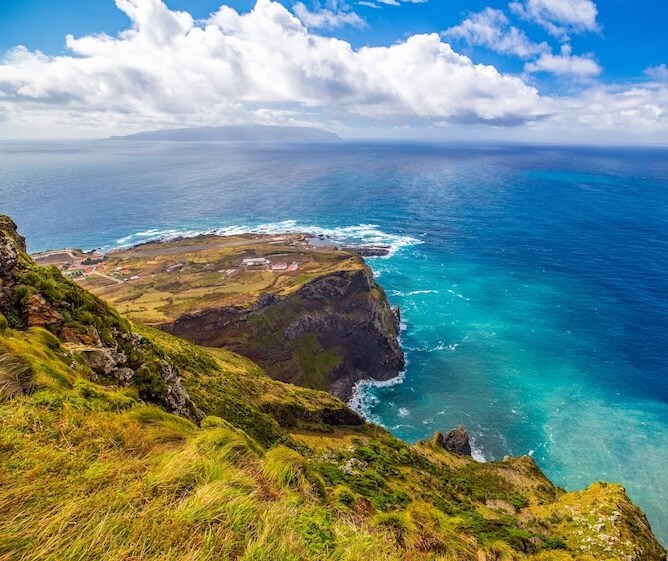
In addition to the Caldeirão viewpoint, there are two other viewpoints worth visiting on Corvo Island. One of them is the Portão viewpoint, right at the top of Vila do Corvo, which gives you a clear view of the town and, on days with good visibility, the island of Flores itself. The other viewpoint is called the Cabeça do Indio viewpoint and is included in the trail with the same name.
Discover the island’s history at the Corvo Ecomuseum
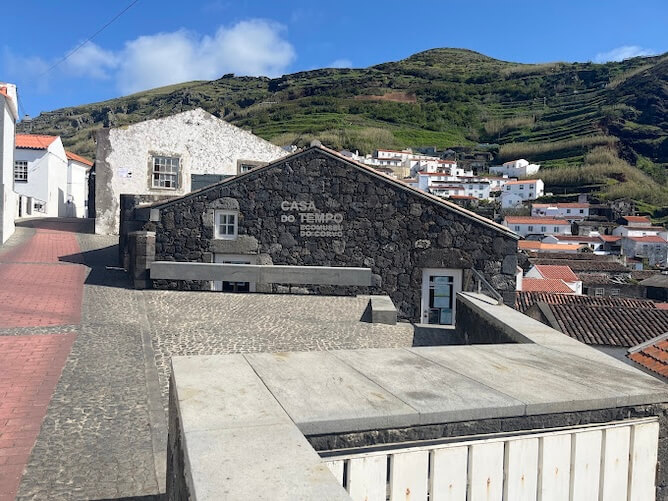
The Casa do Tempo – Ecomuseum of Corvo is a small but impressive museum about the history of the island’s population, known as “corvinos”.
The museum has two floors. The lower floor has a screening of pictures from the life on Corvo, and a short video presentation of how the island was created.
The upper floor had a time line on the wall with important dates of Corvo’s history. There are also a few PC’s available to check the collection old pictures from Corvo and even genealogical research of the local families.
The explanations are in English, and the host is friendly.
I think one of the best things to do in Corvo island is visiting this small museum because, in fact, the courage and resilience of the Corvinos, demonstrated over centuries of inhabiting an island with very few natural resources and with such an adverse climate, is extraordinary.
Price: free entrance.
Opening hours: Monday to Friday, 09h30 to 17h00. Closed on weekends.
Visit the Wild Birds Interpretation Centre
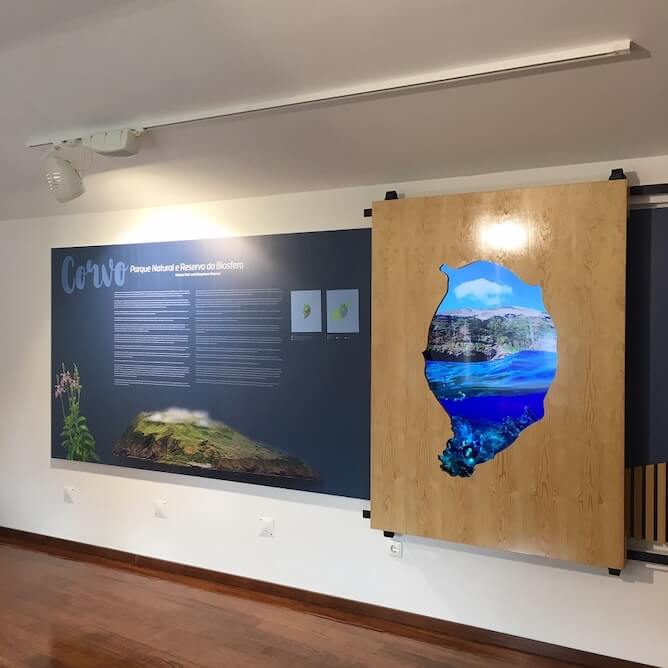
I had no idea when I booked my trip to Corvo in October, but this island is especially popular in autumn as it is one of the best places for birdwatching in the Azores. So, before you start photographing all the birds, I recommend you visit the Corvo Wild Bird Interpretation Centre.
Here you can see some of the species that can be seen on the island, such as the roseate tern, the stagbird or the Madeira storm petrel, as well as those that visit the European continent from the American continent, such as the sandpiper, the American woodpecker or the blue warbler.
Price: free entrance.
Opening hours: Monday to Friday, 09h00–12h30 and 13h30–17h00. Closed on weekends.
See the creations of Bordalo II
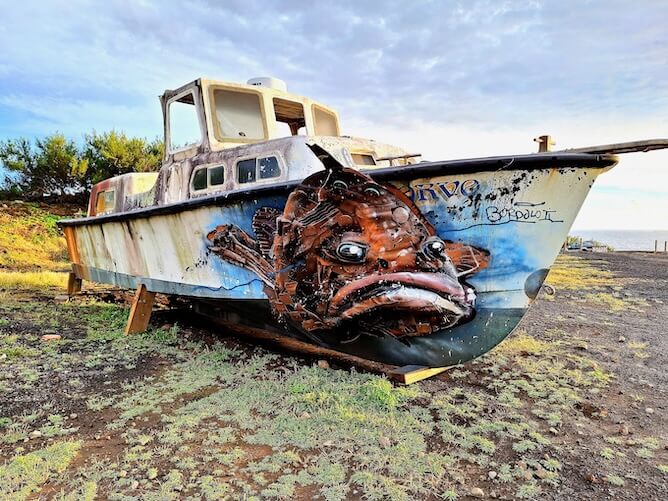
For those who don’t know, Bordalo II is a Portuguese street artist who is very well-known for his sculptures made from trash, which resemble animal shapes. I LOVE his work (in fact, there are several of his works in my city, Porto), so I was surprised when I recognized one of his works on the tiny island of Corvo… I was immensely happy! :)
You can see his sculpture (called “Mero by Bordalo II”) on a boat right in front of the only beach on the island.
Enjoy the only beach on Corvo island
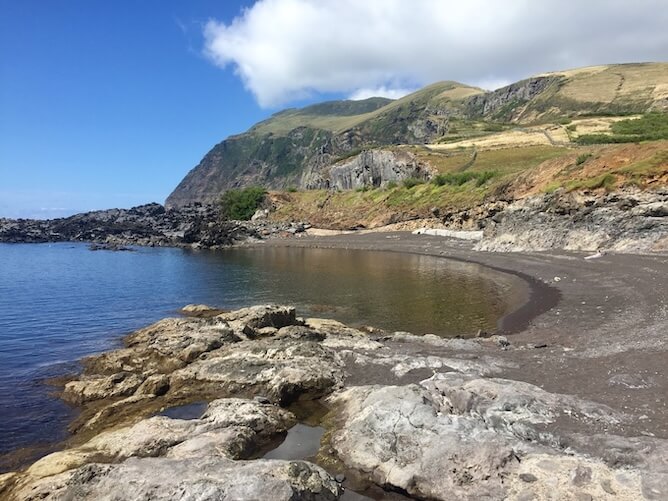
Corvo Island has only one beach, known as Portinho da Areia (on Google Maps you can find it under the name “Praia da Areia”). It is a small beach with black, volcanic sand, which is a rarity in itself, since most beaches in the Azores are made of pebbles or, even worse, are all paved. They say that the water temperature is usually around 20ºC (between May and October) and, in fact, when I went there in October, the water was great!
If the weather is good, one of the best things to do in Corvo island is to go for a swim – just make sure there are no jellyfish in the water, or you might end up getting stung by one!
See the famous windmills of Corvo island
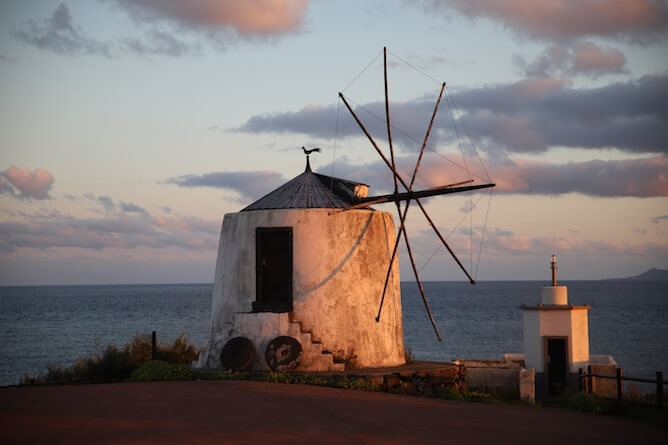
Near the beach there are three mills that were used by the local population to grind wheat, corn, rye and barley.
These mills are a testament to a not-so-distant past, when wheat was the currency that paid off the heavy taxes that the local community was subject to.
Fortunately, the improvement in living conditions after the end of the Salazar dictatorship led to the mills being gradually abandoned. However, in 2013 the local authority restored the mechanisms of each mill, making them functional again.
As a result, the mills have been impeccably restored and maintained. And from there, one of the most beautiful sunsets in the Azores can be seen.
Support local crafts
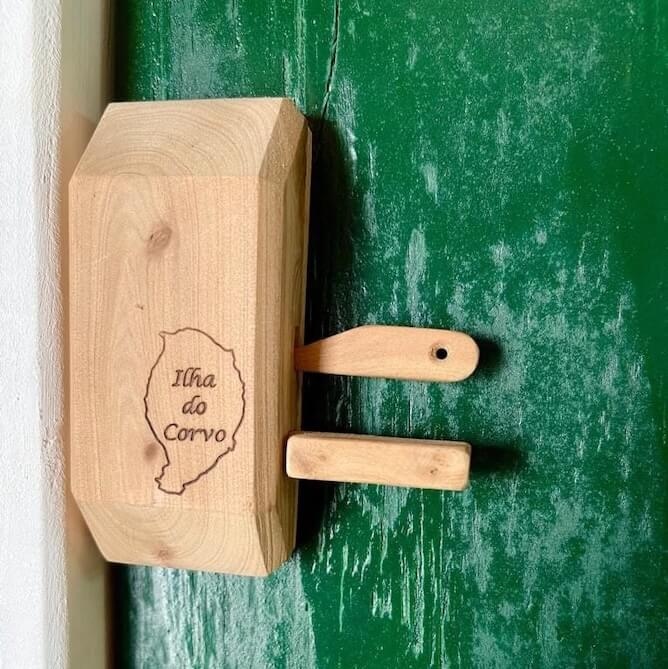
It is curious that an island as small as Corvo has at least two good craftsmen, determined to preserve the island’s traditions. So one of the things to do in Corvo island is to meet them! :)
One of them is Dona Rosa Mendonça, who makes blue hats known as “Barretas do Corvo”. Since there are no sheep on Corvo, Rosa works with acrylic wool or merino wool imported from Ireland. To avoid counterfeits, she registered the Corvino brand. A wool hat costs around €130 (€40 if it is made of acrylic wool) and you can order it at artesanatodocorvo@gmail.com or through her website, and she will send it to you by post.
Another interesting project is “Aparas de Madeira”, owned by David. This magnificent craftsman is dedicated to making the famous traditional locks of Corvo, made 100% from recycled wood from the Cedar-do-Mato (Juniperus brevifolia). It’s true: all the raw material comes from wood reused from old buildings or donated by the Corvo community.
You can find David and see his locks in his workshop in the heart of Corvo Island: Rua da Matriz.
Opening hours: Monday to Saturday, 8am to 5pm.
Practical information about your trip to Corvo island
How to get there
I already wrote a very detailed guide about how to get to Corvo Island.
Basically you have three options, and they all departure from Flores Island, very near Corvo Island. You can:
- Join a group Corvo Boat Trip and Island Sightseeing Tour. I think this is an interesting option because, in addition to taking you to Corvo Island, the skipper of the boat will also shows you the fantastic caves, waterfalls and islets of the Flores island on the way :) You will also get the chance of meeting like-minded travellers, which is great.
Price: €58/person
Departure time (from Flores): 9am
Departure time (from Corvo): 3pm
Book your group Corvo Boat Trip and Island Sightseeing Tour as it gets sold out super fast (it’s a tiny boat!).
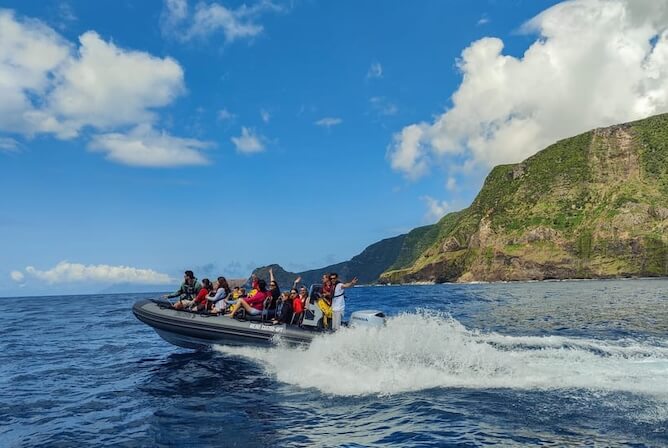
- Another option is to take a speedboat with Atlântico Lines, the ferry company that makes the boat connections between the different Azorean islands.
This option is cheaper but, of course, the boat driver will not show you the various points of interest on Flores Island, nor will he talk to you about dolphins and whales. It is, exclusively, a transport service between islands.
Price: €30/person (round trip)
Departure time: it depends a lot on the time of year. Atlântico Lines changes its schedules every two months, so you’ll need to check their website closer to your travel date. - You can also catch a plane in Flores Island.
When to visit Corvo island
The best time to visit Corvo Island is for sure during the summer months: June, July and August.
Many people also love to go to Corvo in September and October to watch migratory birds, but go at your own risk: at this time of year, the weather is very unstable.
Except during the summer months, the weather in Corvo and in Flores Islands is suuuuper unstable, which may compromise not only your ability to explore the island but, more importantly, your ability to even get to Corvo Island or to leave it. That’s right. There’s plenty of stories of people that got stock in the island for an extra week!
Should I stay in Corvo or just do a day trip?
I think Corvo Island has enough beautiful things to spend two days there, but for practical reasons I recommend a day trip to Corvo from Flores Island.
Corvo Island is TINY. It only has two modest guesthouses, a decent restaurant and a small grocery store. You can’t rent a car, there are no health centers or even pharmacies. In other words, it’s not the most comfortable place in the world.
Nonetheless, if you decide to stay there, check my article about Where to Stay in Corvo Island.
1 and 2 days itinerary in Corvo island
If you only have ONE day in Corvo, I recommend the following itinerary:
10h00 Arrival at the port
10h30 Hiking trail PRC02 COR Caldeirão
13h00 Catching the taxi back to Corvo village
13h15 Visit to Corvo’s museum
14h15 Explore Corvo’s artisans
15h00 Departure from the port, back to Flores Island.
If you have If you have TWO day in Corvo, I recommend the following itinerary:
Day 1
10h00 Arrival at the port
10h30 Hiking trail PRC02 COR Caldeirão
13h00 Catching the taxi back to Corvo village
13h15 Visit to Corvo’s museum
14h15 Explore Corvo’s artisans
16h00 Have a swim at Corvo’s beach
18h00 Watch the sunset near the windmills
Day 2
10h00 Hiking trail PR01 COR Cara do Índio
13h00 Lunch in the village
14h00 Visit the Wild Birds Interpretation Centre
15h00 Departure from the port, back to Flores Island
Should I bring my own food to Corvo island?
Look, you do you, but I was deeply traumatized by not finding fresh food in FLores island, as I have explained in this article. So no one will ever find me that off guard again! And on Corvo island the difficulties are MUCH greater than in Flores, because there are only 2/3 cafes on the entire island, zero supermarkets and a small grocery store, to serve not only the local population (~400 people) but also the dozens of people who visit the island every day.
Therefore, for safety and even logistical reasons, I personally recommend that you take some already prepared sandwiches, and some canned goods, to safeguard yourself during your short stay in Corvo.

